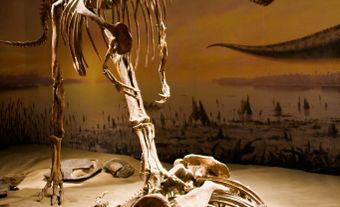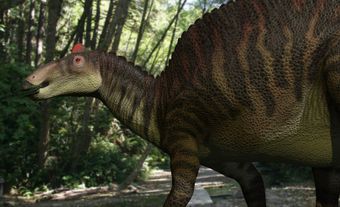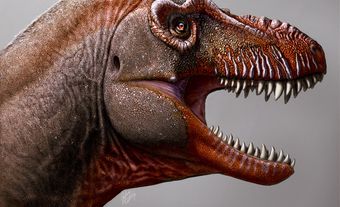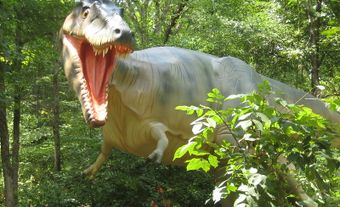Ornithomimus (pronounced or-NEETH-oh-MY-mus) is a genus of medium-sized, plant-eating, theropod dinosaur that looked like an ostrich. Paleontologists recognize two species of Ornithomimus, one of which, Ornithomimus edmontonicus, lived in Canada. It existed between 72.6 to 69.6 million years ago in Alberta, although individuals that lived as far back as 76.5 million years ago have also been referred to as that species. Ornithomimus was covered with primitive, down-like feathers and sported wings that it used for courtship and display. Feathers were first discovered on Ornithomimus by François Therrien, a paleontologist at the Royal Tyrrell Museum of Palaeontology, in 2008 — the first time a feathered dinosaur had been discovered anywhere in the Western Hemisphere.

Description
Ornithomimus belongs to a group of theropods called ornithomimids, which resembled modern ostriches. It measured up to 3.8 m long and weighed up to 170 kg. It had a long tail, a long neck connecting to a small head, a large gut, long powerful hindlimbs, and long forelimbs, each bearing three digits. The fingers of the hand were equipped with long, straight claws, which it may have used to grasp branches.
Unlike most theropods, which had sharp, serrated teeth for slicing flesh, Ornithomimus lacked teeth. Instead, it had long, slender jaws covered by a small keratinous beak, like birds. It also had very large eyes, suggesting that it had good eyesight.
Although often represented in movies and books with a leathery skin, several skeletons discovered in Alberta demonstrate that Ornithomimus had feathers. The body was covered with short feathers that looked like down or hair. However, the underside of the tail and most of the hindlimbs did not have feathers. Adults had larger, rigid feathers on the forearm, which formed a primitive wing, but young individuals did not have wings. The colour of the plumage is currently unknown.
Did you know?
“Ornith” and “mimus” derive from Greek words for “bird” and “mimic.” Ornithomimus edmontonicus was named for the rock unit in which it was discovered, the lower Edmonton Formation (now called the Horseshoe Canyon Formation). Another genus of dinosaur that lived in Canada, Edmontosaurus, is named after the same rock unit.
Range and Habitat
Paleontologists know of only one species of Ornithomimus that lived in Canada, O. edmontonicus. They found fossil remains attributable to this species in the Horseshoe Canyon Formation of southcentral Alberta. It lived between 72.6 and 69.6 million years ago. Paleontologists also recovered several skeletons from the Dinosaur Park Formation of southern Alberta. Although these skeletons are slightly older (76.5 to 75.5 million years ago, they attributed them to O. edmontonicus as well. The Dinosaur Park Formation skeletons, however, could represent a different species.
Ornithomimus lived on a subtropical coastal plain on the western shore of the Western Interior Seaway, an inland sea that connected the modern-day Arctic Ocean to the Gulf of Mexico, dividing North America in two. The habitats in which Ornithomimus lived changed dramatically over millions of years in response to changes in sea levels and drainage conditions, as well as climatic fluctuations. Its habitats varied from warm and humid wetlands to dry and cool forested landscapes.
Reproduction and Development
Although presumed to have laid eggs, paleontologists have not discovered eggs or eggshell fragments for Ornithomimus or any ornithomimid. This could be because ornithomimids nested in environments where it was unlikely for their eggs to be buried by river sediment and eventually fossilized. However, a recent study suggested that most dinosaurs laid soft-shelled eggs, like many lizards and turtles. Soft-shelled eggs are less likely to fossilize than hard-shelled eggs.
Paleontologists have not found fossils of hatchling ornithomimids, but a partial skeleton of a yearling Ornithomimus reveals that the animal was approximately 1.5 m long. Young individuals were covered with filamentous feathers, but did not have wings like adults. Wings developed as the animal reached sexual maturity and would have been used for courtship (e.g., to attract a mate), display (e.g., to scare away a competitor or a predator), and possibly to keep eggs and hatchlings warm.
Diet
Even though Ornithomimus is a member of the theropod lineage (i.e., meat-eating dinosaurs), its lack of teeth and the presence of a beak suggest that it was a plant eater. The discovery of Asian ornithomimid skeletons with rounded stones in their stomach, called gastroliths, indicate these animals swallowed rocks to help grind the plant matter they ate, similar to many modern birds. The exact type of plants ornithomimids ate is unknown.

Behaviour
Numerous tracksites and bonebeds found in Asia demonstrate that ornithomimids travelled in small herds. These herds numbered about 14 or more ornithomimids, and were composed predominantly of very young individuals (1–2 years old) and a few slightly older individuals (3–7 years old). No adults travelled in the herds. This suggests that young ornithomimids lived apart from mature individuals until they reached the age of reproduction. In North America, ornithomimid skeletons are usually found alone, but one fossil site in Alberta’s Horseshoe Canyon Formation preserves at least three nearly fully-grown ornithomimid individuals buried together. This finding suggests that North American ornithomimids also lived in herds.
The shape and size of the brain in Ornithomimus indicates that its sense of smell was poorly developed, suggesting it may have relied more on eyesight. Based on their long legs and inferred large leg muscles, paleontologists think ornithomimids were fast runners, capable of reaching speeds of between 30 km/h and 60 km/h, and maybe even up to 80 km/h. These speeds are similar to those reached by modern ostriches.
Discovery
Paleontologists have discovered numerous ornithomimid skeletons in Alberta since the beginning of the 20th century, which are now on display in museums all over North America. In 1901, Canadian paleontologist Lawrence Lambe discovered the first Canadian ornithomimid skeleton in what is now Dinosaur Provincial Park, Alberta. American paleontologist George F. Sternberg, when working for the Geological Survey of Canada, discovered the first skeleton of Ornithomimus edmontonicus in 1916 near the town of Drumheller, Alberta.

Nearly a century later, François Therrien, a paleontologist at the Royal Tyrrell Museum of Palaeontology, discovered feathers on an Ornithomimus skeleton in 2008. Located near the town of Drumheller, Alberta, the discovery marked the first time a feathered dinosaur had been found anywhere in the Western Hemisphere. Moreover, it was the first time that feathers were found on an ornithomimid anywhere in the world.
Based on the study of three feathered Ornithomimus specimens, it was revealed that wings first evolved for display and courtship. Only later, through evolution, were they used for other purposes, such as flight. Furthermore, the specimens demonstrated that feathers do not require special conditions to be fossilized. They can be preserved in sandstone and not just fine-grained rocks as previously thought. As such, it is possible that feathers may have been present in the ornithomimid specimens discovered in the early 20th century, but were not recognized at the time and inadvertently destroyed during technical preparation.

Many ornithomimid specimens are preserved in a “death pose,” with the neck and tail curled over the back of the animal and the limbs folded in. This posture occurred when a dead carcass was submerged underwater. The buoyancy of the water allowed the animal’s tendons to pull on body parts without obstruction from ground friction or muscle tension prior to being buried under sediment.

 Share on Facebook
Share on Facebook Share on X
Share on X Share by Email
Share by Email Share on Google Classroom
Share on Google Classroom



